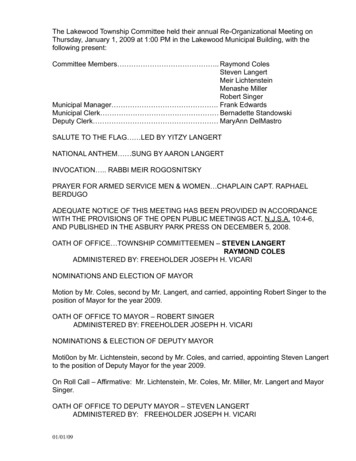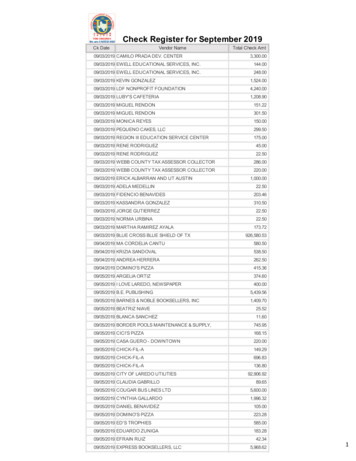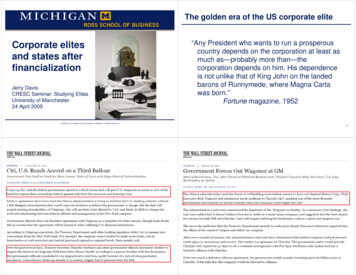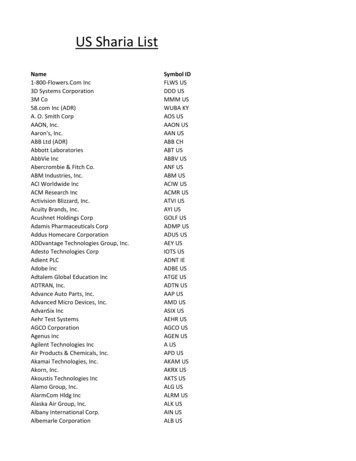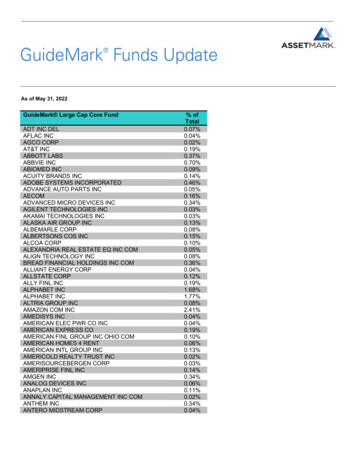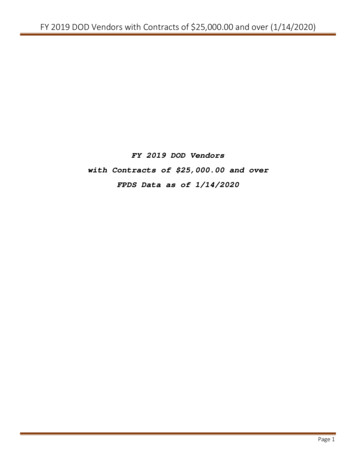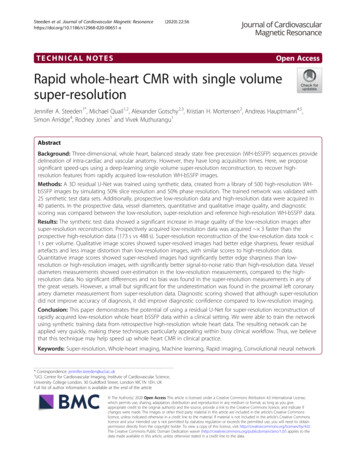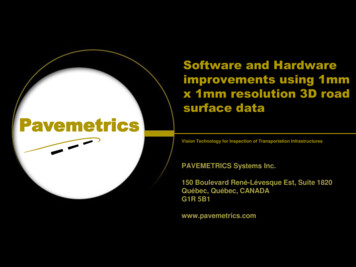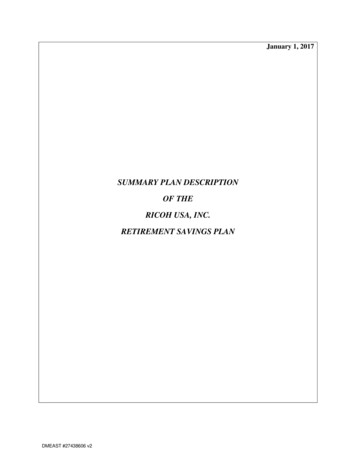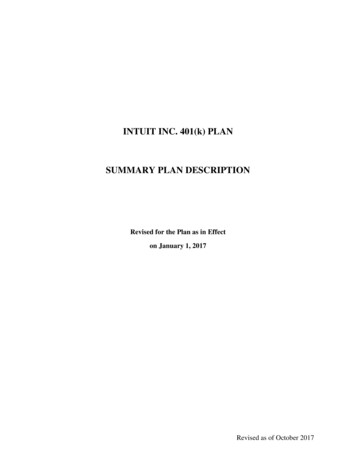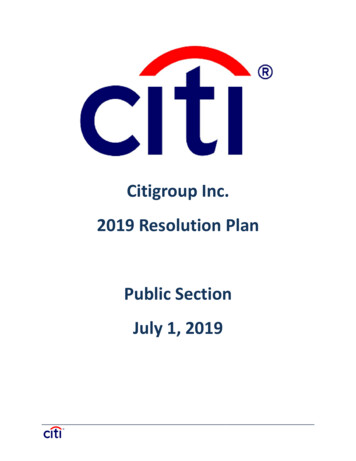
Transcription
Citigroup Inc.2019 Resolution PlanPublic SectionJuly 1, 2019
Citi 2019 § 165(d) Resolution PlanPublic SectionIntroductionTable of ContentsA.Introduction . . 1B.The SPOE Strategy . 3B.1. Overview of the SPOE Strategy . . 3B.2. Citi Support Agreement . . 4Objects of Wind Down, Objects of Sale Divestiture Strategy, and the ResultingB.3. Organization . . 6C.Why Citi Is Resolvable . . . 9C.1. Single Integrated Trigger Framework . . 9C.2. Sufficient Financial Resources Appropriately Positioned . . 13C.3. Ability to Deliver Financial Resources Where and When Needed . . 15C.4. Operational Resilience and Continuity . . 17C.5. Robust Separability and Wind-Down Plan . . 20C.6. Significant Flexibility and Optionality . 23C.7. Integration into Business-As-Usual Governance, Processes, and Infrastructure . . 25D.Actions Taken to Address Shortcomings and Deficiencies . . 29E.Description of Core Business Lines . . 30E.1. Banking CBLs . 30E.2. Markets & Securities Services CBLs . . 31E.3. Global Consumer Banking CBLs . . 32F.Background Information on Material Legal Entities . . 33F.1. Parent and IHC . . 36F.2. Banking Entities and Branches . 40F.3. Broker Dealer Entities . 60F.4. Service MLEs . . 66G.Resolution Planning Corporate Governance Structure and Processes . . 88H.Summary Financial Information Regarding Assets, Liabilities, Capital, and Major FundingSources . 91H.1. Financial Summary - Citi Consolidated . . 92H.2. Funding and Liquidity . 93I.Description of Derivative and Hedging Activities . . 97J.Memberships in Material Payment, Clearing and Settlement Systems . . 99Page i
Citi 2019 § 165(d) Resolution PlanPublic SectionK.Description of Foreign Operations . . 100L.Material Supervisory Authorities . . 104M.Principal Officers of Citigroup Inc. . 105N.Overview of Material Management Information Systems . . 106O.Forward-Looking Statements . . 109P.Glossary . . 110Page ii
Citi 2019 § 165(d) Resolution PlanPublic SectionA. IntroductionCiti is committed to ensuring that it can be resolved in a safe, efficient and orderly manner that avoidsthe use of taxpayer funds and minimizes the impact to depositors, customers, counterparties, and theU.S. and global financial systems. As part of this commitment, Citi evaluates, on an ongoing basis, itsgovernance, processes, and infrastructure to support the execution of its Resolution strategy. The 2019Resolution Plan marks the latest step in a multi-year effort Citi has undertaken to further embedResolution Planning into Business-As-Usual (BAU) processes, infrastructure, and governance in order toensure the sustainability and operational readiness of Resolution planning across the organization.As of December 31, 2018, Citi had a Common Equity Tier 1 Capital ratio of 11.9% based on the Basel IIIStandardized Approaches for determining risk-weighted assets, well in excess of the regulatory thresholdof well-capitalized, and approximately 403.7 billion in high-quality liquid assets (HQLA). Citi had anaverage liquidity coverage ratio (LCR) of 121% for the fourth quarter of 2018 under the U.S. LCR rules,also well above the minimum requirement. Citi’s financial resources provide it with the capital andliquidity to withstand significant financial stress.In addition to strengthening its financial resiliency, Citi continues to make Recovery and Resolutionpreparedness a company-wide priority. Citi’s Board of Directors and management remain committed todemonstrating that, in the event of severe financial distress, Citi can be resolved through a bankruptcyproceeding in a safe, efficient, and orderly manner that minimizes the impact to depositors, customers,clients, counterparties, and the U.S. and global financial systems. As a result, Citi continues to investconsiderable resources in simplifying its business model and legal entity structure and strengthening itsResolution planning and execution capabilities.Citi’s preferred Resolution strategy remains a single point of entry strategy (SPOE Strategy) under whichCitigroup Inc. (Citigroup Parent) would enter bankruptcy, but Citi’s material legal entities (MLEs) wouldcontinue operating for the benefit of the Citigroup Parent bankruptcy estate. Specifically, under the SPOEStrategy, Citi’s Operating MLEs - which are MLEs that contain operating businesses and include Citibank,N.A. (CBNA), Banco Nacional de Mexico, S.A. (Citibanamex), and certain broker dealers, among others would be recapitalized so that they would continue operating throughout Citi’s Resolution. In addition,Citi’s Service MLEs - which are MLEs that house shared service functions - are prefunded with at least sixmonths of working capital, enabling their continuity during Resolution.The SPOE Strategy is designed to (i) minimize the impact of Citi’s Resolution on the U.S. and globalfinancial systems, depositors, clients, and counterparties, (ii) maintain continuity of Citi’s core businesslines (CBLs), critical operations (COs), and material legal entities (MLEs), and (iii) maximize the value ofCiti’s businesses for the benefit of the Citigroup Parent bankruptcy estate. Citi believes that neither thePage 1
Citi 2019 § 165(d) Resolution PlanPublic SectionU.S. government nor the Federal Deposit Insurance Corporation (FDIC) deposit insurance fund wouldincur losses under the SPOE Strategy. Rather, shareholders and unsecured creditors of Citigroup Parentwould absorb any losses.As described further throughout this Public Section, Citi is resolvable under the SPOE Strategy because ithas: A Single Integrated Trigger Framework that enables it to understand when to take appropriateactions to execute the SPOE Strategy; Sufficient financial resources that are appropriately positioned at Citi’s legal entities to execute theSPOE Strategy; The ability to deliver financial resources required by Operating MLEs for the execution of the SPOEStrategy and implemented mitigants to address potential obstacles to delivery; Capabilities to maintain the continuity of internal shared services, third-party vendor services, realestate access, and financial market infrastructure (FMI) access during Resolution; Credible divestiture and wind-down options for its businesses; Flexibility and optionality by developing mitigants for key sources of uncertainty; and Enhanced its practices, infrastructure, policies, and procedures to automate processes and furtherembed Resolution preparedness into its ongoing daily operations.The remaining portion of this Public Section of Citi’s 2019 Resolution Plan discusses the following: Section B provides an overview of the SPOE Strategy; Section C summarizes Citi’s Resolution capabilities, including key enhancements Citi has madebased on the regulatory guidance issued by the Board of Governors of the Federal Reserve System(FRB) and the FDIC on December 20, 2018 (2019 Resolution Plan Guidance) for the 2019 §165(d)Resolution Plan submissions of the eight largest and most complex domestic banking organizationspursuant to Title I of the Dodd-Frank Wall Street Reform and Consumer Protection Act, byoutlining the key reasons Citi is resolvable; and Sections E. through P. further describe the 2019 Resolution Plan, including information on Citi’sCBLs and MLEs, operational continuity, and governance, as well as provide information required byrelevant rules and guidance.Page 2
Citi 2019 § 165(d) Resolution PlanPublic SectionB. The SPOE StrategyCiti’s 2019 Resolution Plan sets forth a single preferred strategy, the SPOE Strategy. This section describesthe SPOE Strategy, the Citi Support Agreement (CSA), Citi’s strategy for winding down and divesting itsbusinesses during Resolution, and the resulting organization. The SPOE Strategy has been developedbased upon a hypothetical idiosyncratic failure scenario and on assumptions provided to Citi by the FRBand the FDIC. It does not reflect Citi’s view of likely future events. Instead, it provides a set of steps,based upon those assumptions, which Citi would take to safely resolve itself without reliance ontaxpayer funds in the unlikely event that Citi were to fail.B.1. Overview of the SPOE StrategyThe SPOE Strategy has three key high-level steps: Recapitalization: In the period leading up to and at Citi’s point of non-viability, the Operating MLEswould be recapitalized pursuant to the contractually-binding CSA (see section B.2. Citi SupportAgreement below for more information) under which Citicorp LLC (Citicorp), as Citi’s intermediateholding company (IHC), would provide capital and liquidity support to the Operating MLEs asneeded. In addition, the Service MLEs have been prefunded with at least six months of workingcapital to enable their continuity during Resolution.Page 3
Citi 2019 § 165(d) Resolution PlanPublic Section Transfer: Citigroup Parent would enter bankruptcy, and Citigroup Parent’s subsidiaries, includingCiticorp and the MLEs, would be transferred to a newly created bank holding company, NewCitigroup. New Citigroup would be held by a Reorganization Trust for the benefit of the CitigroupParent bankruptcy estate. Divestiture/Wind-Down: Over time, Citigroup Parent’s subsidiaries would be segmented intoObjects of Sale and divested pursuant to Citi’s Objects of Sale Divestiture Strategy or wound down.The proceeds of the divestitures would become part of the bankruptcy estate and wouldultimately be distributed to Citigroup Parent’s stakeholders. Each Object of Sale would besignificantly smaller and less systemically important than Citi is today. The Objects of SaleDivestiture Strategy and resulting organization are discussed in more detail in Section B.3. Objectsof Wind Down, Objects of Sale Divestiture Strategy, and Resulting Organization below.For a discussion of financial and operational interconnections for each MLE and how they are maintainedunder the SPOE Strategy, please refer to Section F. Background Information on Material Legal Entities.B.2. Citi Support AgreementThe CSA, which Citi entered into on July 1, 2017, is an interaffiliate agreement that contractually bindsCitigroup Parent and Citicorp to provide capital and liquidity support to all of the Operating MLEs in theunlikely event of Citi's failure so that they can continue as going concerns outside of resolution orbankruptcy proceedings. Citi maintains Citicorp as its IHC to facilitate the operation of the CSA. Citicorp iswholly owned by Citigroup Parent and holds the Operating MLEs other than two broker dealer MLEs.Pursuant to the CSA, Citigroup Parent prefunded Citicorp by making an initial contribution of assets,including liquid assets and interaffiliate loans, to Citicorp. Citigroup Parent must make additionalcontributions to Citicorp as it acquires new funding in excess of certain limits. In business-as-usualconditions, Citicorp serves as the primary funding vehicle for all of the Operating MLEs and providescapital and liquidity to the Operating MLEs consistent with Citi’s existing policies and procedures. TheCSA provides two mechanisms under which Citicorp is required to transfer cash to Citigroup Parent forCitigroup Parent’s debt service and other operating needs: (i) interest and principal payments on fundingnotes issued by Citicorp to Citigroup Parent, and (ii) a committed line of credit under which CitigroupParent may borrow from Citicorp. Citicorp may also issue dividends to Citigroup Parent.Page 4
Citi 2019 § 165(d) Resolution PlanPublic SectionThe graphic below illustrates the flow of funds under the CSA in BAU conditions:As indicated below, upon the occurrence of the Recapitalization Trigger at the point of non-viability andjust before Citigroup Parent enters bankruptcy proceedings, the CSA requires Citigroup Parent to transferits remaining liquid assets to Citicorp through a final contribution, except for a holdback amount foradministrative expenses for Citigroup Parent’s bankruptcy, and requires Citicorp to recapitalize theOperating MLEs and provide them with ongoing support throughout Citi’s Resolution. In addition, thefunding notes issued by Citicorp to Citigroup Parent would be converted into equity and the committedline of credit would terminate.Page 5
Citi 2019 § 165(d) Resolution PlanPublic SectionThe graphic below illustrates the changes to the flow of funds under the CSA upon the occurrence of theRecapitalization Trigger.Citigroup Parent’s obligations and Citicorp’s obligations to the Operating MLEs under the CSA are securedby a pledge of substantially all of their assets (except for equity interests in subsidiaries and excludedassets), including certain liquid assets and interaffiliate loans pursuant to a Security Agreement.Citi understands that it must balance holding capital and liquidity resources at Citigroup Parent andCiticorp and pre-positioning such resources directly at the MLEs. Citi continues to leverage a frameworkto determine the appropriate balance of capital and liquidity resources and has incorporated these andother considerations into the 2019 Resolution Plan.B.3. Objects of Wind Down, Objects of Sale Divestiture Strategy, and theResulting OrganizationThe 2019 Resolution Plan contemplates that the entity that exits from Resolution would be significantlysmaller and less systemically important than Citi. The Objects of Sale Divestiture Strategy, first articulatedin Citi's 2015 Resolution Plan, continues to be updated and enhanced. Citi developed the Objects of SaleDivestiture Strategy as a means for disposing its businesses in a hypothetical idiosyncratic ResolutionPage 6
Citi 2019 § 165(d) Resolution PlanPublic Sectionscenario. It does not represent a long-term, value-maximizing strategy for Citigroup Parent stakeholdersoutside of Resolution.It is contemplated that under the 2019 Resolution Plan, Citi’s banking entities and branches, brokerdealer entities, and Service MLEs would be divested or wound-down as follows: Banking Entities and Branches. Under the Objects of Sale Divestiture Strategy, Citi’s bankingoperations (CBNA and Citibanamex) would be segmented into numerous Objects of Sale, all ofwhich would be divested through a series of merger and acquisition (M&A) transactions and initialpublic offerings (IPOs). Citi considered many ways of segmenting its banking operations acrossdifferent businesses and geographies and a range of potential purchasers, including non-U.S.institutions.The Global Consumer Banking businesses would be primarily divested according to geographicboundaries. The U.S. consumer operations would be segmented into a retail bank and a credit cardbank and be sold to the public in IPOs. The international consumer operations would be sold inprivate transactions. In a limited number of countries where the consumer and institutionalbusinesses are highly integrated, they would be offered as a single unit, in either a private sale oran IPO.The Institutional Clients Group global corporate banking operations would be sold as a single unitthrough a private transaction and would continue to serve large corporate clients andgovernments. Other Institutional Clients Group businesses that primarily operate through Citi’sbanking entities would be segmented along their product offerings and sold in privatetransactions. Broker Dealer Entities. The broker dealer entities would undergo a solvent wind-down in anorderly, value-maximizing manner that would minimize both market disruption and creditor andcounterparty losses. Service MLEs. As the Operating MLEs are sold or wound down, the Service MLEs would bedivested as Objects of Sale, sold with corresponding Object of Sales, or wound down if no longerneeded.The proceeds from the divestiture or wind-down of these businesses would ultimately be remitted tothe Reorganization Trust.Each business divested under the Objects of Sale Divestiture Strategy would be significantly smaller andless systemically important than Citi. For example:Page 7
Citi 2019 § 165(d) Resolution PlanPublic Section The largest business that would be sold in a private transaction would be Citi’s global corporatebanking operations. As of December 31, 2018, this business had approximately 484 billion inassets, or represents approximately 25% of Citi’s total assets. The largest business that would be offered in an IPO would be Citi’s U.S. Retail Bank operations.As of December 31, 2018, this business had approximately 133 billion in assets, orapproximately 7% of Citi’s total assets.The asset levels above are based upon the estimated segmentations of the businesses as well as theimpact of both estimated losses and runoff of liquidity in the Resolution scenario.Page 8
Citi 2019 § 165(d) Resolution PlanPublic SectionC. Why Citi Is ResolvableThis section summarizes Citi’s Resolution capabilities and preparedness by outlining the key reasons Citiis resolvable regardless of the Resolution scenario, including: (i) Citi’s Single Integrated TriggerFramework; (ii) sufficient and appropriately positioned financial resources; (iii) ability to deliver financialresources where and when needed; (iv) operational resilience and continuity; (v) robust separability andwind-down plan; (vi) significant flexibility and optionality; and (vii) integration of Resolutionpreparedness into its ongoing daily operations. Citi has assessed the 2019 Resolution Plan against the2019 Resolution Plan Guidance and believes that its Resolution capabilities meet the 2019 ResolutionPlan Guidance.C.1. Single Integrated Trigger FrameworkCiti continues to leverage its Single Integrated Trigger Framework to provide it with a clearunderstanding of its financial condition at each stage of the Resolution time horizon and enable it to takeappropriate actions with sufficient lead time and in the proper sequence to execute the SPOE Strategyeffectively.C.1.a. Objective Metrics Defining Each Stage of the Resolution Time HorizonThe Single Integrated Trigger Framework provides Citi’s Board of Directors and management withobjective, well-defined triggers that define each stage of the Resolution time horizon. These triggersincorporate all of the Resolution-specific capital and liquidity metrics identified by regulators, includingResolution Liquidity Adequacy and Positioning (RLAP), Resolution Liquidity Execution Need (RLEN),Resolution Capital Adequacy and Positioning (RCAP), and Resolution Capital Execution Need (RCEN). Thetriggers are calibrated so that Citi’s Board of Directors and management have sufficient time to takeactions necessary to execute the SPOE Strategy. These capital and liquidity metrics are discussed in moredetail in Section C.2.a Sufficient Financial Resources to Execute the SPOE Strategy.The Single Integrated Trigger Framework identifies seven phases of the Resolution time horizon usingtriggers specifically designed to address the unique characteristics of each phase: Stress Period: The first phase of the Resolution time horizon is the Stress Period. The Stress Periodwould begin with the breach of certain triggers in Citi’s Contingency Funding Plan and CapitalContingency Framework. During the Stress Period, Citi would take certain actions to improve itsfinancial position. Recovery Period: The second phase of the Resolution time horizon is the Recovery Period. TheRecovery Period would begin with the breach of at least one of several triggers set forth in Citi’sPage 9
Citi 2019 § 165(d) Resolution PlanPublic SectionRecovery Plan. These triggers include an array of metrics designed to capture a wide variety ofpotential stresses, including those related to market conditions, operational risk events, capitaland liquidity positions, and profitability. Runway Period: The third phase of the Resolution time horizon is the Runway Period. The RunwayPeriod would begin with the breach of the quantitative Runway Period Trigger, which is calibratedto signal that Citigroup Parent is projected to need to file for bankruptcy within 30 days, or basedon management discretion. Point of Non-Viability: The fourth phase of the Resolution time horizon is the point of nonviability. The point of non-viability would occur upon a breach of the quantitative RecapitalizationTrigger or based on management discretion. The Recapitalization Trigger has been set to the levelwhere Citigroup Parent and Citicorp’s capital and liquidity resources approach the estimatedaggregate capital and liquidity resource needs of the Operating MLEs during Resolution. Initial Stabilization Period: The fifth phase of the Resolution time horizon is the Initial StabilizationPeriod. The Initial Stabilization Period would begin one day after the point of non-viability. Continued Stabilization Period: The sixth phase of the Resolution time horizon is the ContinuedStabilization Period. The Continued Stabilization Period would begin when Citi can begin tomonetize less liquid assets. This ability signals that market conditions have normalized sufficientlyfor Citi to begin to sell down its less liquid positions. Initial Stabilization and Continued Stabilizationtogether comprise the Stabilization Period. Post Stabilization Period: The seventh and final phase of the Resolution time horizon is the PostStabilization Period. The Post Stabilization Period would begin when the Operating MLEs requiringcredit ratings receive ratings upgrades from one of the major ratings agencies, enabling them toaccess unsecured third-party funding.C.1.b. Triggers That Are Dynamic to Reflect Real-Time ConditionsCiti has designed the Runway Period Trigger and Recapitalization Trigger to be dynamic and adjustable toreflect the Board of Directors' and management’s most current assessment of Citi’s financial condition.Citi’s ability to maintain this real-time view is grounded in several characteristics of its triggers: Authoritative Source Data: The Runway Period Trigger and Recapitalization Trigger use data that isderived from Citi’s authoritative source systems, wherever possible, and incorporate the mostrecently available information. Granular, Adjustable Assumptions: The Runway Period Trigger and Recapitalization Triggerincorporate granular assumptions which, in many cases, can be adjusted to account for the specificPage 10
Citi 2019 § 165(d) Resolution PlanPublic Sectioncharacteristics of a stress event. For example, management has the ability to make specificchanges to the expected rate of outflows projected in the Runway Trigger and RecapitalizationTrigger on a product / customer type / geography level. As a result, management can make realtime changes to the expected outflows in the Runway Period Trigger and Recapitalization Triggerto incorporate its most recent assessment of customer behavior and market conditions in anactual stress scenario. Management Actions: Citi has the ability to adjust the measurement of the Runway Period Triggerand Recapitalization Trigger metrics to account for the impact of management actions during astress scenario, including the execution of Recovery actions. By incorporating the impact of theseactions on Citi’s capital and liquidity positions, management can provide Citigroup Parent's Boardof Directors with more timely information, so that these triggers are breached neither too earlynor too late to enable a more effective execution of the 2019 Resolution Plan in the unlikely eventof any breach of the triggers.C.1.c. Clear Actions Linked to Each Trigger with Flexibility Based on the ScenarioAs part of the Single Integrated Trigger Framework, Citi has linked each of its triggers to a set of actionsso that each of the actions required for the effective execution of the 2019 Resolution Plan are taken in acoordinated manner across businesses and functions and with sufficient time for their timelycompletion.Some triggers are linked to actions through legal contracts or policies. For example, under the CSA, uponthe breach of the Recapitalization Trigger at the point of non-viability, Citicorp would be contractuallyobligated to provide the Operating MLEs with support contributions and support loans to meet anyshortfalls in Resolution capital and liquidity needs. Other triggers are indicators for management to takecertain actions (and are linked to specific expected actions), but management retains the flexibility tomodify the timing of those actions or the way in which the actions are taken based on the specifics ofthe Resolution scenario. Key illustrative actions incorporated into the Single Integrated TriggerFramework include the following: Recovery Actions: Upon the breach of a Recovery trigger, the framework provides that Citi wouldimmediately notify Citi’s Capital Committee (a senior management committee) and Board ofDirectors and, if required, initiate actions outlined in the Contingency Funding Plan (CFP), CapitalContingency Framework (CCF), and/or Recovery Plan, among other actions. Runway Actions: Upon the breach of the Runway Period Trigger and in anticipation of CitigroupParent filing for bankruptcy, the framework provides that Citi’s senior management wouldimmediately notify the Capital Committee and Board of Directors. Additionally, Citi would prepayPage 11
Citi 2019 § 165(d) Resolution PlanPublic Sectioncertain vendor contracts, as required, so as to maintain continuity of service following CitigroupParent’s bankruptcy, and prepare relevant bankruptcy documents, among other actions. Point of Non-Viability / Recapitalization Actions: Upon the breach of the Recapitalization Trigger,the framework provides that Citigroup Parent would transfer its remaining liquid assets to Citicorp,less a holdback amount for administrative expenses for Citigroup Parent’s bankruptcy, pursuant tothe CSA, and Citi would convene a meeting of Citigroup Parent’s Board of Directors to considerfiling for bankruptcy, among other actions.Throughout the Resolution time horizon, Citi would actively communicate with its U.S. and foreignregulators to explain the Recovery and Resolution actions it is taking or planning to take. Citi would alsoactively communicate with external stakeholders (e.g., investors, clients and customers), as appropriate,during each of these phases.C.1.d. Detailed Step-by-Step Playbooks for All Key ActionsCiti’s triggers are linked to certain actions through the CSA, Resolution playbooks, and internal policies. Inparticular, Citi has developed and updated numerous Resolution playbooks to guide the timely andcoordinated execution of its Resolution actions. These playbooks include the specific steps thatmanagement would be prompted to take to effectively execute the SPOE Strategy.Citi’s Resolution playbooks include: Trust Structure Playbook, FMI Playbooks, Governance Playbooks, Object of Sale Playbooks, Communications Plan and Communications Playbooks, Staff Substitutability Playbooks, Derivatives Wind-Down and Novation Playbooks, and Rating Agency Playbook.To address the legal obstacles that could arise from emergency motions that Citi would file for thetransfer of subsidiaries from Citigroup Parent to New Citigroup and the 2019 Resolution Plan Guidance,Citi continues to leverage its Bankruptcy Playbook that is integrated into the Trust Structure Playbook.The Trust Structure Playbook also includes a pre-drafted emergency transfer motion and other relevantfirst-day bankruptcy motions and documents.Page 12
Citi 2019 § 165(d) Resolution PlanPublic SectionC.2. Sufficient Financial Resources Appropriately PositionedCiti has estimated the financial resources required to meet its needs in Resolution and believes it has: Sufficient financial resources to execute the SPOE Strategy based on estimates of RCAP, RCEN,RLAP, and RLEN, which Citi has the ability to calculate on a daily basis; Conservative assumptions in its estimation of those resolution resource needs, with buffers toaccount for sources of uncertainty; and Appropriate balancing and positioning of those resources to mitigate potential risks, withsufficient pre-positioned resources at the Operating MLEs and contributable resources held atCitigroup Parent and Citicorp.Citi’s conservative estimation of its financial resource needs and positioning to meet these needs helpsto ensure that the Operating MLEs would remain solvent throughout the Resolution time horizon.C.2.a. Sufficient Financial Resources to Execute the SPOE StrategyCiti believes it has sufficient capital and liquidity resources to execute the SPOE Strategy under a widerange of potential scenarios and has established the processes, policies, infrastructure, and governanceso that it maintains these resources in business-as-usual conditions. Citi’s methodology for determiningits Resolution resource needs is based on its RCAP, RCEN, RLAP, and RLEN estimates, and Citi believes itholds sufficient financial resources in the form of liquid assets, regulatory capital, and Internal Total LossAbsorbing Capacity (Internal TLAC) to meet each of these resolution resource needs as of July 1, 2019.Citi has incorporated conservative assumptio
U.S. and global financial systems. As part of this commitment, iti evaluates, on an ongoing basis, its governance, processes, and infrastructure to support the execution of its Resolution strategy. The 2019 Resolution Plan marks the latest step in a multi-year effort iti has undertaken to further embed
